Translate This Page
AGM BATTERIES IN MOTORHOMES/TOURING CARAVANS?
AGM batteries are designed for use with Stop/Start engines.
The very nature of their build, is that when charging at high currents, typically 120 to 180Amps and discharging in short bursts every time the engine is restarted the plates can't buckle due to the use of Glass Matt into which the dielectric is absorbed creating a physical barrier between the plates. Unlike a conventional battery that has a Wet or Gel substance as the dielectric which can't stop physical damage if heavily charged or discharged.
In a "conventional" battery and we can include the EFB (enhanced flooded battery) range of products, the battery uses thermal convection to assist in cooling the dielectric as it charges at a relatively low current, which in a Motorhome or Touring Caravan is usually between 15 to 30Amps. When an AGM battery is charged in this manner the heat can't be dispersed so can cause the pressure to build up to the point of splitting the case. When an AGM battery is used as a vehicle (starter) battery for an engine which uses Stop/Start technology its charge and discharge time is insufficient for the heat to build up.
AGM batteries require a higher charge voltage due to the makeup of the dielectric, typically 2.47 to 2.49 volts per cell so a six cell nominally 12volt battery will need an absorption voltage of between 14.82 and 14.94 volts to obtain a full charge. As batteries of different technologies, requiring different voltages, can't be charged from the same source a vehicle that is fitted with a Stop/Start engine and an AGM vehicle battery can only have an AGM battery for the habitation services. Not ideal and AGM batteries tend to fail prematurely. Most chargers that have an AGM setting will either only charge at the absorption rate of a short period, typically one hour or will have a temperature sensor that must be attached to the battery for proper use. This will almost always result in the habitation battery never reaching full capacity. In most installations the habitation battery is charged from the alternator when the engine is running by use of a split charge circuit. If the alternator is designed to charge Lead technology batteries it will be putting out 14.2 to 14.4 volts so the AGM battery which will be connected in parallel with the vehicle battery will be constantly undercharged.
In short, we don't recommend the use of AGM batteries for habitation use unless the vehicle has a Stop/Start engine and is fitted with an AGM starter battery and an AGM compliant mains charger.
An issue we often come across is that an AGM battery has been fitted for habitation use because the Charger/PDU has a setting for AGM yet the vehicle battery is Wet Lead. As in most installations the vehicle battery is also charged when on EHU (Electrical Hook Up), the higher voltage will be charging the Wet Lead battery as well and often causes damage. Not only to the battery but also to other on board electronics like alarm systems and even the vehicles ECU. We see this allot with the Schaudt EBL30 and EBL119 because, as part of the way the quality control is carried out, the units leave the factory set to AGM and manufactures and dealers don't understand that you can't mix technologies.
The below battery is one of several models being rolled out by Swift. You can see from the label the minimum charge voltage is 14.4v and the ideal a massive 15.0v. Whichever way you interpret that, the battery likes a voltage much higher than the 13.9v many UK motorhomes charge the habitation battery at.
.jpg?timestamp=1544474361981)
You will note that Wet Acid batteries never have the charging voltage printed on the casing, so to print a much higher voltage range must mean it is critical to it's operation and lifetime? Note the lower than usual Float/trickle voltage of 13.65, not the usual 13.8v of most motorhome chargers.
Also ask yourself why the bottom line says "Do not Charge in a Gas tight container"?
If these are as 'Gas free' as some retailers claim, where is the risk, unless they do gas?.
If you look at the Banner web site you will see that AGM technology has had it's time. Almost all the new quality Leisure batteries currently being announced are Flooded/Wet EFB technology.
AGM hardly gets a look in on the new battery ranges.
The Banner website actually states that "EFB is the technology of the moment".
The latest big truck batteries are also coming onto the market with EFB technology. If AGM is the 'Super Tough' technology we were being told it was, why are hard working Truck Batteries now being rolled out with EFB technology?
Banner quote on their web pages that one of the Weaknesses of AGM is it needing 'A higher charge voltage' (as stated above) and shorter life under high cyclic loads, see the chart below -.
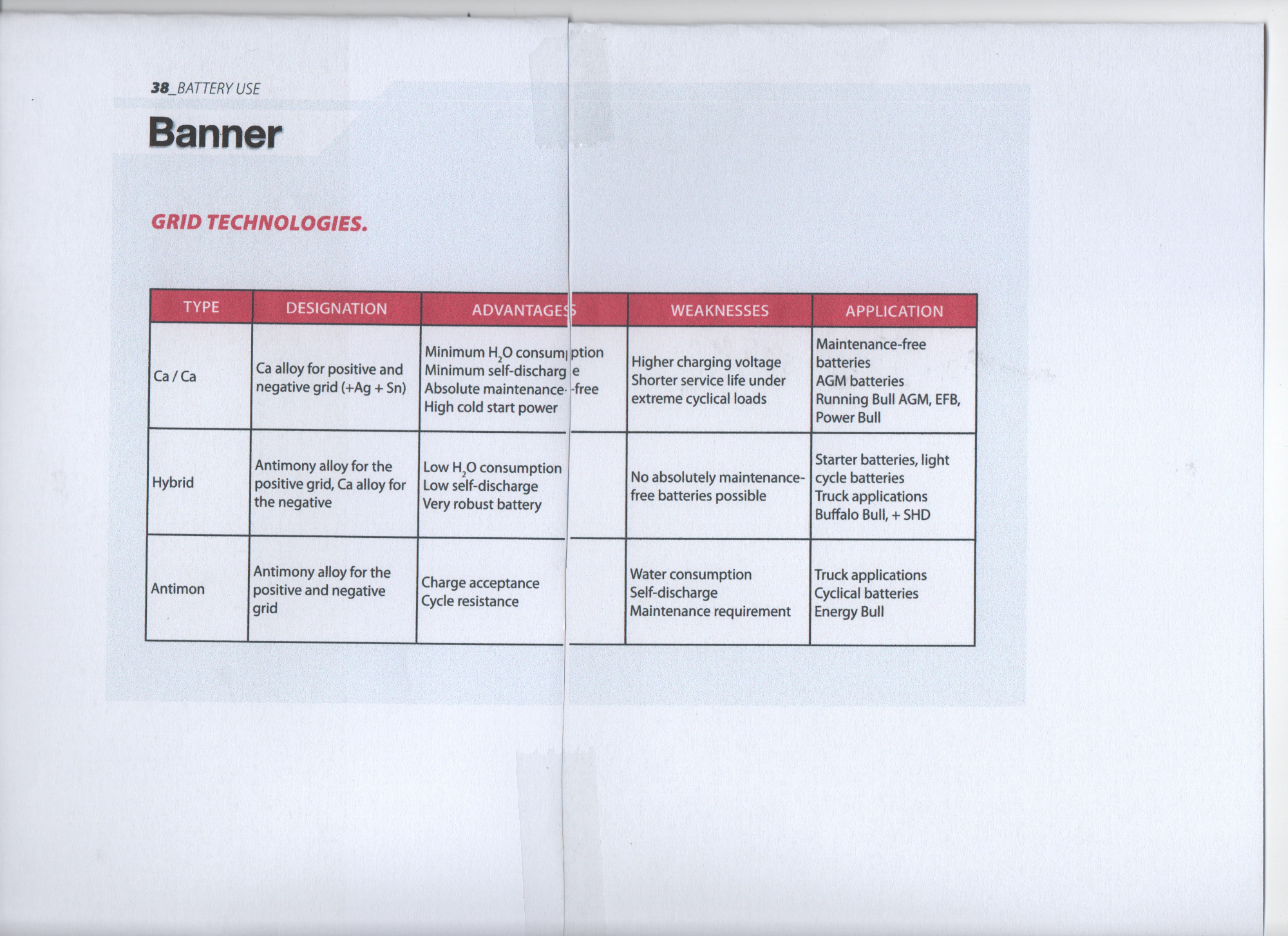
Shorter life under high cyclic loads?
That is quite a turnabout, as 4 years ago the retailers marketing arms telling us that AGM batteries were the heavy duty option, excelling at high loads. Wasn't that the reason they were adopted for Stop/Start cars, because they handled the high duty workload better?
That AGM have have not performed as the marketing men claimed is further supported by them falling out of favour in the Automotive world Audi, VW, BMW, Seat, Mercedes and Skoda are ditching AGM batteries from their cars and are moving back to Lead acid Wet/Flooded technology that are also lower cost than AGM. Landrover are also moving away from AGM.
Conventional wet acid/flooded Starter batteries in Cars have previously had an average 9 year life. Fitting double the cost AGM's with claims of more than double the life should mean they last 20 years.
So why are AGM's being replaced in cars after less than 3 years life?
While an AGM might appear on paper as a suitable battery technology, just as they haven't worked in Cars, they don't work well in motorhomes, but for several different reasons.
The biggest and nicest surprise to support our drive for better awareness that most Motorhome and almost all Caravan chargers are not suitable for AGM batteries, has come from a Caravan and Motorhome Club magazine article. In September 2018 issue, Page 114, is an article on 'Choosing Leisure Batteries'.
For the first time ever, there is published advice from the Caravan and Motorhome industry to actually avoid AGM batteries!!
The C&MC article states something like :-
"In general, it's probably best to avoid AGM batteries unless you are absolutely sure your charger is suitable, as the otherwise excellent performance counts for little if the performance is compromised through damage by inappropriate charging".
Hopefully things will now change and the whole industry will also start warning people about AGM's in motorhomes?
But it isn't just the 230v mains chargers in Caravans and Motorhomes that don't support AGM batteries. The Alternators don't either, often charging at much less than the 14.4v the battery industry believe is the norm.
Some UK motorhome Alternator charge systems are so poorly designed that In recent tests the Alternator voltage reaching the Habitation area batteries was as low 13.4, less than a mains batteries 'trickle' charge, and typically 13.7v. This isn't just the odd motorhome, but the majority of UK motorhomes are charging the habitation batteries at well below their potential.
You can probably imagine how an AGM battery, that requires 14.8v, will last at being so under charged by 13.7v?
Alternator Charging Of AGM Batteries?
This recent MMM Forum thread below documents how prevalent poor Alternator charging of the Leisure batteries is in the majority of UK motorhomes. While wet/flooded batteries will be tolerant of these conditions, AGM won't, leading to premature AGM battery failure and loss of capacity.
Explosion of the battery or fire is also not unknown with AGM batteries, which are more prone to Thermal Runaway than other Lead batteries.
The Forum thread below has contributions from many different people with differing views representing a broad spectrum, yet the ultimate conclusion is very different to that perceived by the battery Industry.
See the thread here, starting at the post dated 21 August 2018 8:44 PM :
It highlights how many Motorhomes have flawed Alternator charging system that don't achieve the expected 14.4v charge rate.
In the above MMM Forum thread, while much of the evidence we put forward is contradicted, several real world examples then go on to back up our statements.
One Poster, after running a test to 'prove we were wrong', wrote,
"All I can say is... lesson learned and point taken Allan........ my (Alternator charge) voltage was a miserable 13.7-13.9V"
Three cheers for Alpha Batteries, the first battery retailer we have seen that has a warning about AGM batteries needing the correct charging system. Their website states -
"Please ensure your charging method can accommodate AGM batteries as charging at non AGM charge settings can adversely affect the life of the battery. Please contact us if you are unsure".
Well done those guys, you are streets ahead of the NCC who heavily promote unsuitable AGM's without any such warning.
That turnabout in now acknowledging an AGM's true disadvantages fits in exactly with the reported premature failures in the automotive World and them being withdrawn and swapped for Wet Acid/Flooded batteries.
AGM In The Automotive World.
Audi, VW, Seat and Skoda are ditching AGM batteries from their cars and are moving back to Lead acid Wet/Flooded technology that are also lower cost than AGM.
Allegedly BMW are preparing to do the same. Some BMW Dealers have been replacing failed AGM batteries with a Wet Acid technology version, Enhanced Flooded Batteries (EFB), for some years to very good effect.
While 'Not so heavy duty on paper' EFB last much longer than AGM in real use.
Landrover are also moving away from AGM.
Mercedes have already swapped one of the two AGM batteries in the the highline cars to EFB technology, and the rumours are the other battery will follow soon.
Just like in Motorhome use, the general view in the battery industry now is that AGM just don't deliver the promised performance.
So What Is This Page All About?
We started this page some years ago because as far back as 2014 we began to see Motorhome and Caravan Electronics being damaged by prematurely degraded Absorbed Glass Mat (AGM) batteries, that sometimes led to fires, battery explosion.
AGM batteries typically require a 14.8v charging rate for maximum performance and life, when almost 50% of all the UK Caravans on the roads have a 13.5v/13.8v charger.
We were recently challenged on this statistic by a big battery retailer who stated all Caravan/motorhome chargers now made in the last 10 years are all "Smart and powerful delivering a range of voltage settings".
If that is so, why does the Sargent 151, 155 and the EC160, a new variation of which has been recently released, only have a single stage, fixed voltage of 13.5v? These units and many like them have been the main stay of the British Caravan and Motorhome industry since the 1990's.
Another example are the BCA chargers fitted in Baileys, Lunars, Elddis, etc. For years the same style low technology 13.5v/13.8v chargers as Sargent,
Only in the last couple of years have BCA updated their chargers to 3 stage and a max 14.2v.
Big names like Zig, Bonus Systems, etc have never had a high technology mains charger, just low technology, 1990's style, fixed 13.5 voltage 'charger' which are little more than a power supply..
Yet this photo below of a VMF AGM battery shows it is so fussy about the charge voltage, it lists it on the casing as 14.6v - 14.8v :
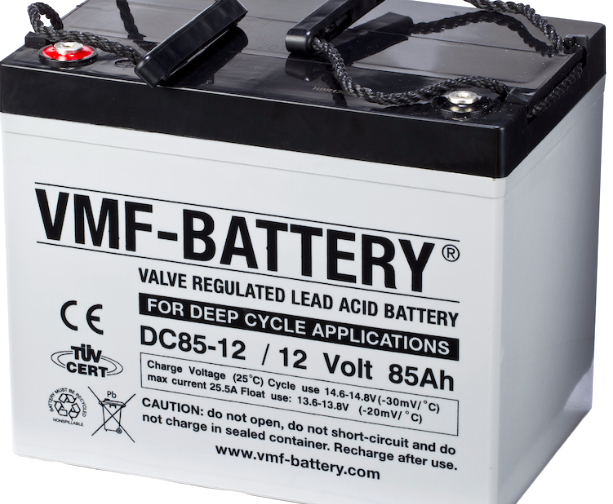
Ask yourself why you don't find such information on the casing of a wet Acid battery?
Wet Acid technology is so super durable, the voltage they charge at doesn't need to be stated, they are so tolerant of anything from 13.5v to 14.4v.
But doesn't that also suggest the need to print the voltage on the casing is a gigantic step up in a AGM batteries very precise charging voltage and getting it wrong will have consequences?
So how will a 14.8v AGM fare on a Swift motorhome with a 13.5v Sargent charger and an Alternator output that struggles to reach 13.8v? Logic suggests it is going to be very slow to charge or even fail to get fully charged, failing prematurely and this is exactly what is being witnessed.
Swift are not rolling out AGM optimised Solar regulators with their new 'AGM' policy, just using the old 13.8v continuous charge Solar Regulator, which is yet another issue.
But regardless of the above and whether we are to be believed, AGM technology hasn't delivered and is being ousted by the newer, more tolerant, lower cost EFB wet Acid Technology.
BMW, AUDI, VW are proof of that.
Don't let the Dealer fit an AGM battery in your motorhome.
When AGM batteries have demonstrated they don't deliver, it's time to think more about EFB which are 100% Motorhome and Caravan compatible.
Hence Yuasa launching their latest Leisure battery, the new Yuasa L36-EFB with best in class performance at 'Budget' money.
Banner have launched many EFB batteries with more to come and make the point on the website they work well with ALL existing Caravan and Motorhome chargers.
Banner also specifically state that "EFB is the technology of the moment".
For years Wet/Flooded Acid batteries have happily tolerated recharge voltages from the 13.8v of a typical Caravan power supply/charger to the very high 16v output by Ford Cars and Vans.
But AGM batteries are very fussy about several factors, not just voltages.
AGM batteries can display deep cycle characteristics in laboratory tests, but only within very narrow confines and limitations of operation which are rarely achieved in the field.
Confines such as an exact charging voltage, narrow band continuous current draw limitations, plus the most crucial : temperature operation. If the battery is operated outside these narrow limits, battery life won't be the 10 year life you have every right to expect from a £200 AGM battery, but usually less than two years.
Did you know that when an AGM battery goes through it's Laboratory 'Cycle' testing to assess it's capability, it sits in a bath of cold Water to keep the temperature low and constant? With AGM batteries being so susceptible to temperature highs, it is likely to deliver a lot more cycles in the Lab than it can ever achieve in real world Motorhome use.
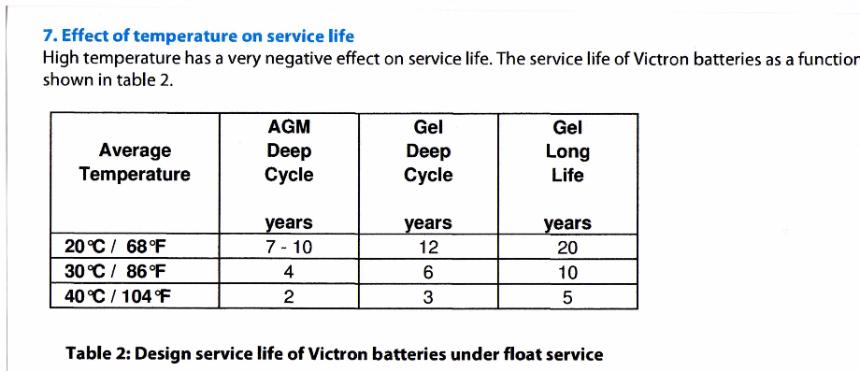
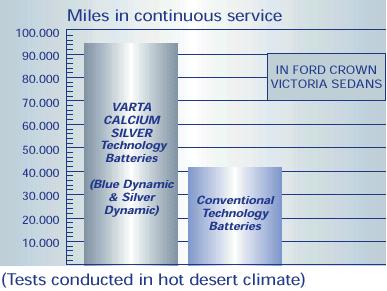
There is a very good reason why the Battery being voted 'Best for Trucks' is not an AGM, but a Wet/flooded battery.
The latest big Truck Battery from Yuasa, that was originally scheduled to be AGM, is rolling off the production line using EFB technology.
AGM OPTIMISED CHARGERS
Some Charger manufacturers might tell you that their chargers are 'AGM compatible', but the AGM battery manufacturers websites disagree. Any old charger with more than about 14.3v may 'charge' an AGM battery, but it won't necessarily charge it properly or quickly.
If a chargers advertising blurb states it is 'AGM compliant', but it does not have a separate 14.8v AGM specific charge profile, such as the Rovert charger range which has only 14.4v 'Wet' and 'Gel' settings, then the retailer doesn't know their product.
Victron Energy, Schaudt, Votronic, etc. spend thousands on developing charge profiles optimised to get the best from each battery Technology. I am pretty sure they would not spend that money if they could get away with a single profile?
You can therefore imagine how good a 'low voltage' Sargent EC500/PX300 will be?
The manual states -
"the voltage rises to 14.4V to deliver the bulk charge to the battery. When the battery is charged, the voltage is decreased at stage 3 to 13.6V to deliver a float charge to maintain the battery in the fully charged state".
Yet Sargent also say in the same EC 500 manual, "The PSU is configured to work with standard lead acid leisure batteries, and in most cases is also compatible with the latest range of Absorbed Glass Matt (AGM) batteries".
Note the wording of 'compatible', not optimised. To me that suggests it might 'work' but not the best it can be, when AGM need the best charging and operating conditions.
Clearly no modern Motorhome AGM Leisure battery is going to work that well or last with those voltages, but then the manual does have a 'get out' clause -
"Before fitting non-standard batteries please check that the charging profile described in 3.3 is suitable for the type of battery by referring to the battery documentation or battery manufacturer".
In other words, "we are going to save ourselves lots of R & D by telling you it's compatible, but if you trust us without doing your own homework, it's your problem".
A bit of History on the Leisure battery chargers installed in Caravan and Motorhome's
If you think the reason that 99% of british Motorhomes and Caravans failure to have an AGM optimised charger is historical, with lots of old fashioned, outdated chargers still in old vehicles from yesteryear, you would be wrong.
Even the latest offerings from Sargent don't comply with the minimum stated spec of the big AGM battery manufacturers for even half reasonable AGM battery performance or life.
Yes it is true that old fashion, single stage chargers of 13.5v - 13.8v dominated for most British built Caravans and Motorhomes up to about 2004. Chargers like those from Zig, Plug In Systems, BCA, etc were almost all 13.5v - 13.8v fixed output chargers, fitted in Swift's, Lunars, Coachman's, Elddis etc.
The BCA/Powerpart unit alone is probably fitted in more UK Caravans than any other unit in the 'modern' British age. They were even being used in new Elddis motorhomes up to a couple of years ago.
The BCA 13.8v (often actually less than 13.8v in real use) is still on sale now and often used as a replacement for other manufacturers failed factory original. Yet it has a weak 10amp/13.8v specification not suited to an 80Ah caravan battery, let alone a free camping Motorhome's 160Ah AGM battery bank.
Around the year 2005'ish Swift started installing Italian designed Nordelettronica NE143, multi stage chargers that were probably the first efficient, modern battery chargers used by a main stream UK builder.
With a 3 stage, peak 14.4v output, they revolutionised charging times and battery capacity.
An indication of just how poor the UK Caravan industry is in this area, despite being designed nearly 15 years ago, the Nordelettronica NE143 units are, even now, amongst the most advanced in the sector.
Sadly even the latest Nordelettronica UK spec charger version introduced in 2016 doesn't have an AGM charge profile.
But it has gained a charging profile for Gel, which incredibly, was a milestone for the UK market as Gel charging profiles are almost as rare as AGM.
Both the latest Sargent 151 with it's fixed, single 13.8v output and the EC600 with it's peak 14.4v wet acid only battery output, were released in the last 2 years. That's right, the Sargent EC151, a '1980's single stage specification' charger, with a fixed 13.5v, weak 10amp output was released in 2017.
Incredibly, the very poor Sargent 151 is one of the best selling after market chargers in the UK.
These are recent introductions, yet most definitely not modern, but still don't have an AGM charge profile or even Gel.
Even in 2018, few main stream UK built Caravans/Motorhome's have even a Gel profile, let alone AGM.
The Sargent manuals state the chargers are "compatible with AGM batteries" which clearly isn't the way the battery manufacturers see it. Every topline AGM Leisure battery battery manufacturer insists on a minimum 14.7v and Victron Energy suggest 14.9v gets longer life and a fuller charged battery.
We have seen AGM's on a 13.5v Sargent 151 that won't achieve 80% capacity, even after charging for days.
Clearly Sargent don't have it right, but then a disparity between the Sargent version of what is good for a battery and what the battery manufacturers say has arisen before.
The Sargent manuals speak of a feature that shuts down the system when it drops below 9.0v - "...to protect the battery from severe damage".
I think every battery expert in the country would say that battery damage had already occurred at 11v, never mind 9.0v!!!
Yuasa, and all other manufacturers, state that for maximum battery life, a Lead acid battery should not be discharged below 50% Depth Of Discharge (DOD). For a modern battery that is between 12.5 and 12.2v depending on the Technology in the battery, as it is the technology in a battery that dictates the battery State Of Charge voltage.
See Yuasa chart below :
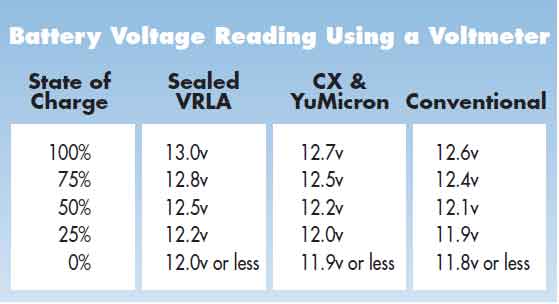
The industry say a Leisure battery can be discharged lower than 50% DOD in an emergency, but 12v should be regarded as a fully discharged battery. Dropping below this level is acknowledged to severely shorten lifetime.
It isn't just a minor anomaly either, the industry say we should regard 50% DOD as 'fully discharged' for all intents and purposes which is about 12.2v, so Sargents '9.0v' cutoff to 'protect the battery' seems to show that they don't understand batteries, so not surprising they think 14.3v is ok for an AGM.
There was a brief glimmer of UK Charger technological enlightenment when Sargent introduced the excellent Dutch designed and built Sargent EC325 charger, which boosted the voltage of the charger to up to 18v, if it thought the battery needed fast charging. Very clever, very well made unit.
But while a tolerant Wet acid battery would accept that, as shown by the Ford Silver wet batteries that survive for years on a peak 16v charge, 18v would degrade a Gel or AGM Leisure battery in months.
The Motorhomes built on the continent are altogether different in Charger design.
The likes of Hymer, Burstner, Frankia, Pilote, Knaus, CI, etc. had a higher technological approach to battery charging in a Motorhome right from the early days.
For example, it was normal as far back as 1999 for a continental built vehicle to have inbuilt automatic, simultaneous charging of the Starter battery as well as the Leisure battery when on mains EHU.
Even in 2018, some UK built Motorhomes still require manual selection of charging either the Starter battery or the habitation area battery, but not both at the same time.
The latest 'new for 2017' Sargent EC600 still requires manual switching between Starter and Habitation area battery. So does the recently updated EC160.
Multi stage fast charging became common on european built vehicles from around 2001.
Most Continental vehicles had a Gel charging program as well as Wet Acid, as far back as 2002.
AGM charging profiles were introduced by Hymer around 2015/2016. Their new Solar Regulator got AGM optimised charging at the same time.
The rest of Europe began options of AGM charging profiles around 2016/2017.
Some have never offered an AGM option, preferring, correctly in our opinion, to believe that Gel batteries are a more 'durable' option than AGM.
As an overall percentage of the UK Caravan and Motorhome market, the inbuilt chargers with an AGM profile is very, very small.
We would guess at less than 0.1%.
Summary:
Can a Wet battery really have more Charge/discharge cycles than AGM?
Even if you ignore all the above, the pennies just don't add up when it comes to AGM.
£ for £ a Yuasa L36-EFB battery will out perform an AGM battery in almost every area, even outperforming an AGM on cycle life.
An AGM might have nearly double the cycle life on paper, but then it costs twice as much. £ for £ you can buy two Yuasa L36-EFB's for the price of one AGM. Two L36-EFB's, used one after the other, will supply 460 REAL cycles versus an AGM's 350 'claimed' cycles.
Example : According to the NCC Battery verification web site, a Banner AGM of the same physical size delivers 350 cycles at a cost of around £210, versus the Yuasa L36-EFB 230 cycles at about £110 each.
So for a similar £210'ish expenditure you could run two Yuasa L36-EFB's, one after the other, for longer overall life than the cost of a single AGM. That actually makes the two Yuasa's more cost effective at 460 cycles vs the AGM's 350 cycles. 110 more cycles for almost the same money, and that assumes that the AGM will deliver those cycles, which history has shown it won't.
Not only does the L36-EFB last longer, but most of those cycles would be more usable with more fully charged, higher capacity batteries without any of the limitations of an AGM battery.
Or, to look at it another way
For almost the same £210 you could install two Varta LFD90's coupled together and discharge each battery to just 25% Depth Of Discharge (DOD) vs a single 90Ah AGM discharged to 50%, to withdraw the same usable 45Ah.
A battery discharged to just 25% DOD will have more than twice the cycle life compared to a single battery discharged to 50% DOD, so a pair of Varta/Bosch Powerframes used in this way will deliver nearly 500 cycles, out performing the AGM's 350 cycles by a huge margin.
The Varta solution would also be a more flexible 180Ah setup where, in an emergency, you could draw up to 90Ah.
Obviously taking the same 90Ah out of a single 90Ah rated AGM would severely shorten it's life.
In monetary terms, the AGM's claimed extra cycles over Wet Acid is misleading.
In real World use a Yuasa L36-EFB or Varta/Bosch Powerframe battery will outperform an AGM, even on cycle life.
If all that is true, why are Motorhome manufacturers fitting AGM batteries as standard?
AGM batteries have a long shelf life, old fashioned 'conventional' Wet Acid batteries don't. A conventional Wet battery, like a Banner Energy Bull, can discharge on the shelf to debilitating levels inside 3 months. Such a level of discharge will lead to Sulphation and deterioration.
When a Motorhome can be sat on a Dealers forecourt for many months, that is a big annual cost in replacement wet batteries and subsequent damage to the charging systems.
Secondly, if an AGM battery does get discharged at the Factory/Dealers, it can usually be recharged with less obvious signs of trauma. Even though it has suffered damage it will initially hide it.
That applies to AGM batteries in the storeroom as well as on the forecourt.
The AGM battery might cost a little more upfront, but that cost is passed on to the customer. The convenience to the Dealer/Manufacturer of installing the perfect battery for them, costs them nothing.
Now that AGM batteries have been shown to be a poor performer and EFB has been crowned the new technology 'King', I would expect more EFB batteries to go on sale with fewer AGM's.

|
lifeline AGM 1 vs GEL manual.pdf Size : 1817.495 Kb Type : pdf |

|
CTEK XS 7.0.pdf Size : 2464.947 Kb Type : pdf |

|
Steca style Solar 30.pdf Size : 615.338 Kb Type : pdf |
